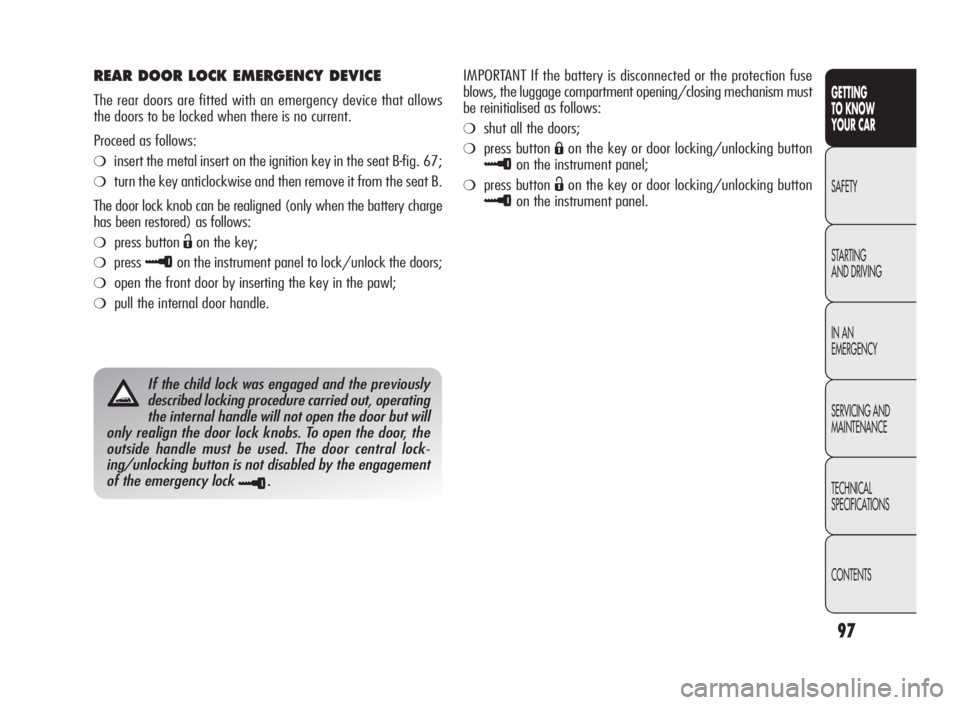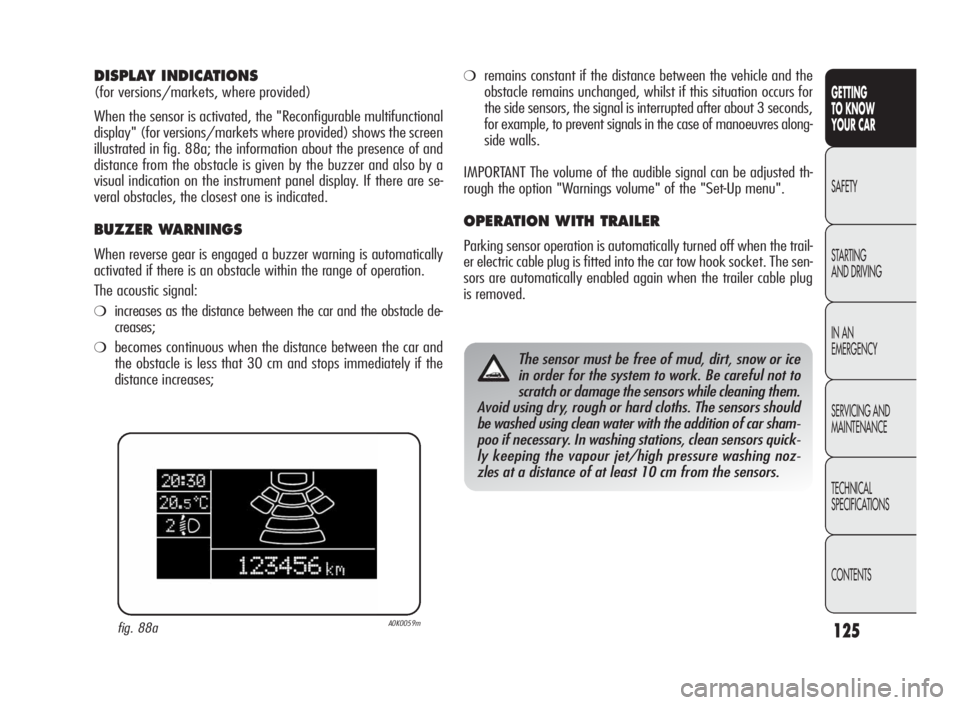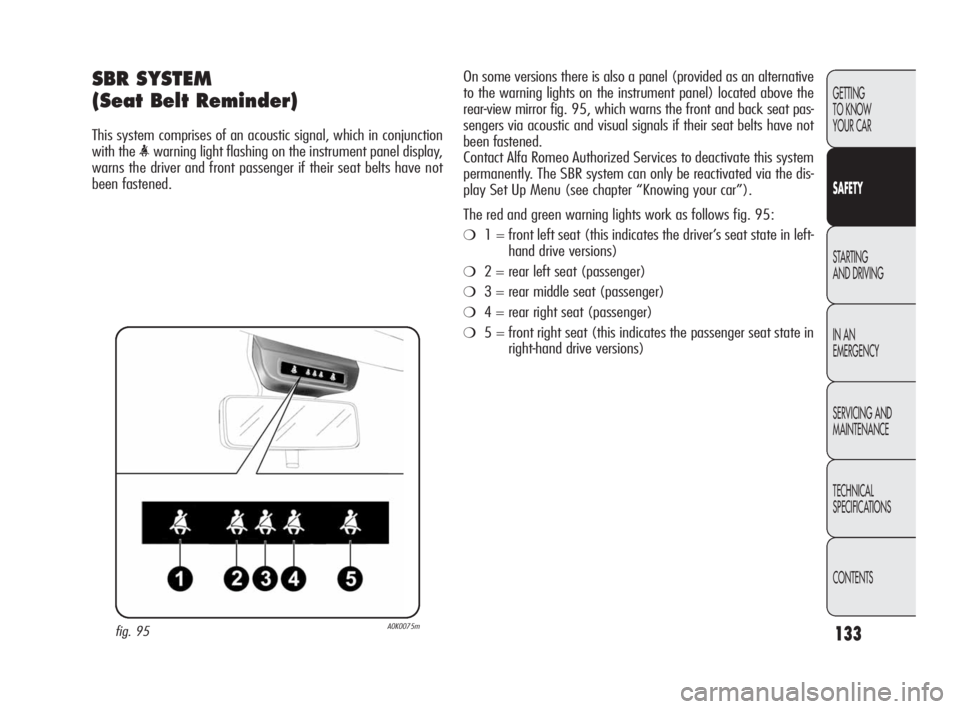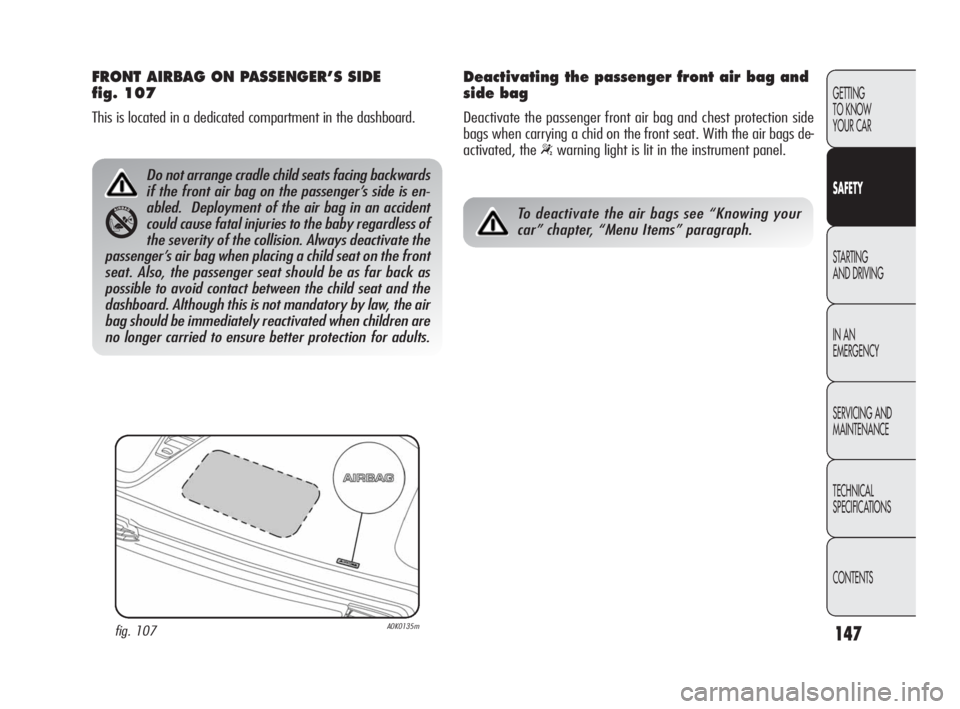instrument panel Alfa Romeo Giulietta 2010 Owner handbook (in English)
[x] Cancel search | Manufacturer: ALFA ROMEO, Model Year: 2010, Model line: Giulietta, Model: Alfa Romeo Giulietta 2010Pages: 294, PDF Size: 5.25 MB
Page 79 of 294

78
GETTING
TO KNOW
YOUR CAR
SAFETY
STARTING
AND DRIVING
IN AN
EMERGENCY
SERVICING AND
MAINTENANCE
TECHNICAL
SPECIFICATIONS
CONTENTS
If the engine is switched off with the stalk in the automatic posi-
tion, no wiping cycle will take place when the engine is started
again even if it is raining. This prevents accidental activation of the
rain sensor when the engine is started (i.e. when the windscreen
is being washed by hand or the wipers are stuck to the windscreen
by ice).
To restore automatic operation of the rain sensor, turn the ring on
the right A stalk fig. 41 from automatic position (AUTO) to
Opo-
sition and then turn A ring back to the AUTO position.
When the rain sensor is reactivated using any of the manoeuvres
described above, reactivation is indicated by a single stroke of
the windscreen wipers, regardless of the condition of the wind-
screen. If the sensitivity of the rain sensor is adjusted whilst it is
in operation, a single stroke of the windscreen wiper takes place
to confirm the changed setting.
In the event of the malfunction of the rain sensor whilst it is ac-
tive, the windscreen wiper operates intermittently at a speed con-
sistent with the sensitivity setting of the rain sensor, regardless of
whether it is raining or not (the sensor fault is indicated on the
instrument panel display). The sensor continues to operate and it
is possible to set the windscreen wiper to continuous mode (1
st
or 2ndspeed). The fault indication remains for as long as the sen-
sorisactive.
RAIN SENSOR fig. 42
(for versions/markets, where provided)
This is an infrared LED sensor fitted on the windscreen. It can de-
tect the presence of rain and consequently manage windscreen wip-
ing in accordance with the amount of water on the windscreen.
Activation
The sensor is activated by turning the A ring fig. 41 to the
“automatic” position (“AUTO”): the frequency of the windscreen
wiper strokes is automatically adjusted depending on the amount
of water on the windscreen. This frequency can vary from no stroke
(no rain - windscreen dry) up to the 2
ndconstant speed operation
(heavy rain - windscreen wet).
Turn the A ring fig. 41 to vary the rain sensor sensitivity.
fig. 42A0K0111m
001-130 Alfa Giulietta EN 5ed 26-07-2010 16:33 Pagina 78
Page 86 of 294

85
GETTING
TO KNOW
YOUR CAR
SAFETY
STARTING
AND DRIVING
IN AN
EMERGENCY
SERVICING AND
MAINTENANCE
TECHNICAL
SPECIFICATIONS
CONTENTS
CONTROLS
HAZARD WARNING LIGHTS fig. 50
Press A switch to switch on/off the lights.ŸandΔwarning
lights come on and the A switch will flash when the lights are
on.
fig. 50A0K0093m
The use of hazard lights is governed by the High-
way Code of the country you are in. Keep to the
rules.
Emergency braking
In the event of emergency braking the hazard warning lights are
lit up automatically along with the
ŸandΔwarning lights on
the instrument panel. The lights are switched off automatically
when the nature of braking changes.
FRONT FOG LIGHTS fig. 51
(for versions/markets, where provided)
Press
5button to switch on/off the lights. Press the button again
to turn the lights off. The
5warning light on the instrument pan-
el and the LED on the button itself will light up when the lights
are on.
REAR FOG LIGHTS fig. 51
Press4button to switch on/off the lights. The rear fog lights
are only enabled with the dipped beam headlights on. Press the
button again to turn the lights off or turn off the dipped beam head-
lights and/or the front fog lights (for versions/markets, where pro-
vided).
4warning light on the instrument panel and the LED over
the button itself will light up when the lights are on.
fig. 51A0K0120m
001-130 Alfa Giulietta EN 5ed 26-07-2010 16:33 Pagina 85
Page 98 of 294

97
GETTING
TO KNOW
YOUR CAR
SAFETY
STARTING
AND DRIVING
IN AN
EMERGENCY
SERVICING AND
MAINTENANCE
TECHNICAL
SPECIFICATIONS
CONTENTS
REAR DOOR LOCK EMERGENCY DEVICE
The rear doors are fitted with an emergency device that allows
the doors to be locked when there is no current.
Proceed as follows:
❍insert the metal insert on the ignition key in the seat B-fig. 67;
❍turn the key anticlockwise and then remove it from the seat B.
The door lock knob can be realigned (only when the battery charge
has been restored) as follows:
❍press buttonËon the key;
❍press≈on the instrument panel to lock/unlock the doors;
❍open the front door by inserting the key in the pawl;
❍pull the internal door handle.
If the child lock was engaged and the previously
described locking procedure carried out, operating
the internal handle will not open the door but will
only realign the door lock knobs. To open the door, the
outside handle must be used. The door central lock-
ing/unlocking button is not disabled by the engagement
of the emergency lock
≈.
IMPORTANT If the battery is disconnected or the protection fuse
blows, the luggage compartment opening/closing mechanism must
be reinitialised as follows:
❍shut all the doors;
❍press buttonÁon the key or door locking/unlocking button
≈on the instrument panel;
❍press buttonËon the key or door locking/unlocking button
≈on the instrument panel.
001-130 Alfa Giulietta EN 5ed 26-07-2010 16:33 Pagina 97
Page 111 of 294

110
GETTING
TO KNOW
YOUR CAR
SAFETY
STARTING
AND DRIVING
IN AN
EMERGENCY
SERVICING AND
MAINTENANCE
TECHNICAL
SPECIFICATIONS
CONTENTS
VDC SYSTEM
(Vehicle Dynamics Control)
This is an electronic system that controls vehicle stability in the
event of tyre grip loss, helping maintain directional control. The sys-
tem is capable of recognising potentially dangerous situations in
terms of the stability and intervenes automatically on the brakes
in a differentiated manner for the four wheels in order to provide
a stabilizing torque.
The VDC, in turn, includes the following systems:
❍Hill Holder
❍ASR
❍Brake Assist
❍MSR
❍CBC
❍“ELECTRONIC Q2” (“E-Q2”)
❍DST
❍RAB
SYSTEM INTERVENTION
This is signalled by warning lightáblinking on the instrument
panel to inform the driver that stability and grip conditions are
critical.
SYSTEM ACTIVATION
The VDC system switches on automatically each time the engine
is started and cannot be switched off.
HILL HOLDER SYSTEM
This system is an integral part of the VDC system and it is provided
to facilitate starting on slopes.
It is activated automatically in the following instances:
❍uphill: car standing on a road with a gradient of more than 5%,
engine on, brake pedals pressed and gearbox in neutral or gear
(other than reverse) engaged;
❍downhill: car at a standstill on a road with a gradient higher
than 5%, engine running, brake pedal pressed and reverse gear
engaged.
When setting off the VDC system control unit maintains the brak-
ing pressure at the wheels until the engine torque required for de-
parture is reached or for approximately 2 seconds, allowing your
right foot to be moved easily from the brake pedal to the acceler-
ator.
If the car does not start off after this time, the system will deacti-
vate automatically by gradually releasing the brake force. A noise
may be heard: this means that the car is about to start moving.
IMPORTANT the Hill Holder system should not be used as a hand-
brake. Do not leave the vehicle without having engaged the hand-
brake, switched off the engine and engaged a gear.
001-130 Alfa Giulietta EN 5ed 26-07-2010 16:34 Pagina 110
Page 114 of 294

113
GETTING
TO KNOW
YOUR CAR
SAFETY
STARTING
AND DRIVING
IN AN
EMERGENCY
SERVICING AND
MAINTENANCE
TECHNICAL
SPECIFICATIONS
CONTENTS
“Alfa DNA” SYSTEM
(Dynamic control system)
This device allows, using switch A-fig. 80 (on the central tunnel),
three response modes to be selected according to driving style
and road conditions:
❍d = Dynamic (for sporty driving)
❍n = Normal (normal driving mode)
❍a = All Weather (driving mode for poor grip conditions, i.e. rain
and snow on the road)
The device also acts on the dynamic vehicle control systems (en-
gine, steering, VDC system, instrument panel).
fig. 80A0K0072m
DRIVING MODES
Switch A-fig. 80 is a monostable switch, i.e. it always remains in the
central position. The selected driving mode is indicated by the corre-
sponding LED coming on in the panel and by an indication on the re-
configurable multifunction display, as illustrated below:
A0K0009m
A0K0010m
Dynamic mode(display image available for
versions/markets where
provided)All Weather mode
“Normal” mode
When “Normal” mode is selected, no messages or symbols are
shown on the display.
VDCandASR: operating thresholds set for normal comfort lev-
el for normal driving conditions.
Steering tuning: functions aimed at providing comfort in nor-
mal conditions of use.
DST: Standard braking control coordinated with ABS/VDC.
Standard control over lateral acceleration.
Oversteer compensation: a slight pulse on the steering wheel
encourages the driver to carry out the most appropriate ma-
noeuvre.
Engine: Standard responsiveness
001-130 Alfa Giulietta EN 5ed 26-07-2010 16:34 Pagina 113
Page 115 of 294

114
GETTING
TO KNOW
YOUR CAR
SAFETY
STARTING
AND DRIVING
IN AN
EMERGENCY
SERVICING AND
MAINTENANCE
TECHNICAL
SPECIFICATIONS
CONTENTS
TURNING “Dynamic” MODE ON/OFF
On
Move lever A-fig. 80 upwards (to the letter “d”) and hold in this
position for 0.5 seconds until the corresponding LED lights up or
the word “Dynamic” appears on the display (see figures). The
switch A will go back to central position after having been released.Electronic Q2: improves traction and reduces understeer in acce-
leration while exiting curves.
RAB: pre-positioning of the brake pads (front and rear) following
a rapid release of the accelerator pedal to reduce braking
times, shorten stopping distances and improve the feel of
the brake pedal.
The activation of the Dynamic mode is also shown by the change
in the instrument panel lighting that, after decreasing, reaches
the highest luminosity and then returns to the previously set va-
lues.
Off
To turn “Dynamic” mode off and go back to “Normal” mode, move
the lever as described above once again. In this case, the LED cor-
responding to “Normal” mode will light up and the words “Nor-
mal on” will appear on the reconfigurable multifunction display
(see figure).
A0K1225gA0K1055g
A0K1052g
VDCandASR: intervention thresholds that allow more enjoy-
able, sportier driving whilst guaranteeing stabil-
ity in the event of loss of control. Improves trac-
tion whilst accelerating on bends.
Steering tuning: sports mode operation.
DST:Standard brake control coordinated with ABS/VDC.
Standard control over lateral acceleration
Oversteer compensation adapted to VDC/ASR intervention
thresholds: a slight pulse on the steering wheel encourage
the driver to carry the most appropriate manoeuvre.
Engine: Prompter response + Overboost to maximise torque (for
versions/markets, where provided).
001-130 Alfa Giulietta EN 5ed 26-07-2010 16:34 Pagina 114
Page 126 of 294

125
GETTING
TO KNOW
YOUR CAR
SAFETY
STARTING
AND DRIVING
IN AN
EMERGENCY
SERVICING AND
MAINTENANCE
TECHNICAL
SPECIFICATIONS
CONTENTS
DISPLAY INDICATIONS
(for versions/markets, where provided)
When the sensor is activated, the "Reconfigurable multifunctional
display" (for versions/markets where provided) shows the screen
illustrated in fig. 88a; the information about the presence of and
distance from the obstacle is given by the buzzer and also by a
visual indication on the instrument panel display. If there are se-
veral obstacles, the closest one is indicated.
BUZZER WARNINGS
When reverse gear is engaged a buzzer warning is automatically
activated if there is an obstacle within the range of operation.
The acoustic signal:
❍increases as the distance between the car and the obstacle de-
creases;
❍becomes continuous when the distance between the car and
the obstacle is less that 30 cm and stops immediately if the
distance increases;
❍remains constant if the distance between the vehicle and the
obstacle remains unchanged, whilst if this situation occurs for
the side sensors, the signal is interrupted after about 3 seconds,
for example, to prevent signals in the case of manoeuvres along-
side walls.
IMPORTANT The volume of the audible signal can be adjusted th-
rough the option "Warnings volume" of the "Set-Up menu".
OPERATION WITH TRAILER
Parking sensor operation is automatically turned off when the trail-
er electric cable plug is fitted into the car tow hook socket. The sen-
sors are automatically enabled again when the trailer cable plug
is removed.
The sensor must be free of mud, dirt, snow or ice
in order for the system to work. Be careful not to
scratch or damage the sensors while cleaning them.
Avoid using dry, rough or hard cloths. The sensors should
be washed using clean water with the addition of car sham-
poo if necessary. In washing stations, clean sensors quick-
ly keeping the vapour jet/high pressure washing noz-
zles at a distance of at least 10 cm from the sensors.
fig. 88aA0K0059m
001-130 Alfa Giulietta EN 5ed 26-07-2010 16:34 Pagina 125
Page 134 of 294

133
GETTING
TO KNOW
YOUR CAR
SAFETY
STARTING
AND DRIVING
IN AN
EMERGENCY
SERVICING AND
MAINTENANCE
TECHNICAL
SPECIFICATIONS
CONTENTS
SBR SYSTEM
(Seat Belt Reminder)
This system comprises of an acoustic signal, which in conjunction
with the
been fastened.
fig. 95A0K0075m
On some versions there is also a panel (provided as an alternative
to the warning lights on the instrument panel) located above the
rear-view mirror fig. 95, which warns the front and back seat pas-
sengers via acoustic and visual signals if their seat belts have not
been fastened.
Contact Alfa Romeo Authorized Services to deactivate this system
permanently. The SBR system can only be reactivated via the dis-
play Set Up Menu (see chapter “Knowing your car”).
The red and green warning lights work as follows fig. 95:
❍1 = front left seat (this indicates the driver’s seat state in left-
hand drive versions)
❍2 = rear left seat (passenger)
❍3 = rear middle seat (passenger)
❍4 = rear right seat (passenger)
❍5 = front right seat (this indicates the passenger seat state in
right-hand drive versions)
131-150 Alfa Giulietta EN 4ed 27-04-2010 11:15 Pagina 133
Page 139 of 294

138
GETTING
TO KNOW
YOUR CAR
SAFETY
STARTING
AND DRIVING
IN AN
EMERGENCY
SERVICING AND
MAINTENANCE
TECHNICAL
SPECIFICATIONS
CONTENTS
CARRYING CHILDREN SAFELY
For optimum protection in the event of a crash, all passengers must
be seated and wearing adequate restraint systems. This is even
more important for children. This prescription is compulsory in all
EC countries according to EC Directive 2003/20/EC. Compared
with an adult, a child’s head is larger and heavier in proportion to
his/her body and the child’s muscular and bone structures are
not fully developed. For this reason, they require restraint systems
which are different from those used by adults to protect them in
the event of an accident.
The result of research in relation to the best protection for chil-
dren is illustrated in European Regulation ECE-R44, which divides
child seats into five groups in addition to making their use com-
pulsory:
Group 0 up to 10 kg
Group 0+ up to 13 kg
Group 1 9-18 kg
Group 2 15-25 kg
Group 3 22-36 kg
All restraint devices must bear the type-approval data along with
the control mark on a label firmly secured to the child seat which
must never be removed. When over 1.50 m in height, from the
point of view of restraint systems, children are considered as adults
and have to wear the standard seat belts.
Should it be absolutely necessary to carry a child
on the front seat in a cradle seat facing backwards,
the passenger’s front air bag and side bag should
be deactivated by using the Set-Up Menu. Deacti-
vation can be verified by checking the
“warn-
ing light in the instrument panel. Also, the passenger seat
should be adjusted as far back as possible to avoid con-
tact between the child seat and the dashboard.
Lineaccessori Alfa Romeo includes child seats for each weight group.
These devices are recommended, having been specifically designed
for Alfa Romeo cars.
Do not arrange child seats facing backwards if the
front air bag on the passenger’s side is enabled.
Deployment of the air bag in an accident could
cause fatal injuries to the baby regardless of the severity
of the collision. It is advisable to carry children in dedi-
cated child seats on the rear seat, which is the most pro-
tected position in the event of an accident.
131-150 Alfa Giulietta EN 4ed 27-04-2010 11:15 Pagina 138
Page 148 of 294

147
GETTING
TO KNOW
YOUR CAR
SAFETY
STARTING
AND DRIVING
IN AN
EMERGENCY
SERVICING AND
MAINTENANCE
TECHNICAL
SPECIFICATIONS
CONTENTS
FRONT AIRBAG ON PASSENGER’S SIDE
fig. 107
This is located in a dedicated compartment in the dashboard.
fig. 107A0K0135m
Do not arrange cradle child seats facing backwards
if the front air bag on the passenger’s side is en-
abled. Deployment of the air bag in an accident
could cause fatal injuries to the baby regardless of
the severity of the collision. Always deactivate the
passenger’s air bag when placing a child seat on the front
seat. Also, the passenger seat should be as far back as
possible to avoid contact between the child seat and the
dashboard. Although this is not mandatory by law, the air
bag should be immediately reactivated when children are
no longer carried to ensure better protection for adults.
To deactivate the air bags see “Knowing your
car” chapter, “Menu Items” paragraph.
Deactivating the passenger front air bag and
side bag
Deactivate the passenger front air bag and chest protection side
bags when carrying a chid on the front seat. With the air bags de-
activated, the
“warning light is lit in the instrument panel.
131-150 Alfa Giulietta EN 4ed 27-04-2010 11:15 Pagina 147